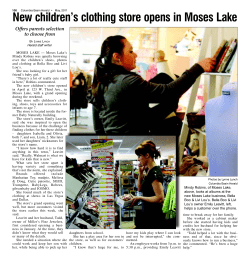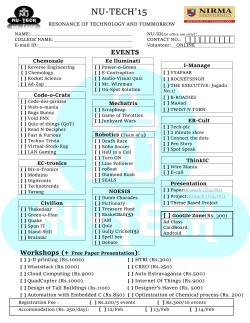
- Macaulay Honors College
SHAPING THE FUTURE OF NEW YORK CITY – HNRS 226 Spring 2015 M & W: 1:40-3:00 pm Room: Honors 12 Instructor: Scott Larson e-mail: scott.larson@qc.cuny.edu Office: Powdermaker 250C Office hours: M & W, noon-1:30 pm or by appointment Instructional Tech Fellow: Andres Orejuela e-mail: aorejuela3@gmail.com Course webpage: http://macaulay.cuny.edu/eportfolios/larson15/ This syllabus is subject to change The aim of this course is to analyze the ongoing interplay of social, economic, and political forces that shape the physical form and social dynamics of New York City. By looking at certain historical junctures and major development policies and initiatives we will study the institutional agents of change in the city – federal, state and city government; public authorities; private sector interests; community boards; and community-based organizations – in order to understand how decisions are made and power and opportunity are (unevenly) distributed in the city. In doing so we will explore the close relationship between physical space and social relations, including the interplay of inequality, race, gender and class. Throughout the semester, students engage in a team research project to be presented at a model academic conference<http://macaulay.cuny.edu/it/?q=node/23> at the end of the semester. COURSE OBJECTIVES In the seminar, students will: 1) Use primary sources, both qualitative and quantitative, especially in their research projects, to understand community institutions, the local economy, and the role of government. 2) Develop an understanding of how power differentially affects New York City’s people, its built environment, and its institutions through site visits, case studies, or research projects. 3) Develop the ability to engage in key contemporary debates that shape the future of the city through in-class discussions, presentations, and colloquia. 4) Develop an understanding of the formal and informal institutions underlying decision making in the city by analyzing historical and contemporary planning and policy issues. REQUIRED TEXT Larson, Scott. 2013. Building Like Moses With Jacobs in Mind: Contemporary Planning in New York City. New York: Temple University Press. All other readings will be posted on the course web page. COURSE REQUIREMENTS/EVALUATION Attendance/participation 3 short writing assignments Course blog posts (2) and responses (2) Group project/presentation 10 points 30 points (10 each) 20 points (5 each post, 5 each response) 40 points Attendence/participation You are expected to show up for class having done the required reading assignments and prepared to discuss them. Short writing assignments: Three 2-3 page short “thought” essays, in which you will take a position on an issue or debate and offer evidence from course readings and materials as well as your own research to support your point of view. Assignment #1 Which early urban feature – Central Park? The institution of the street grid? Zoning? Something else? – most defined and influenced New York City’s spatial, social and economic future? due February 9 Assignment #2 Whose vision – that of Robert Moses or Jane Jacobs – best situates New York City for the future? due March 9 Assignment #3 Is New York a “successful city?” due May 13 Course blog: Posts: TWO times during the semester on assigned dates, each student will be responsible for posting a link to an article (news or scholarly), video, podcast, interactive map, exhibit, data set, report, etc. that relates to the day’s topic. In addition, you will provide us with a brief written statement of how you think the link contributes to our understanding of the topic at hand. Responses: TWICE during the semester, on assigned dates, each student should post a response to the blog post for the day. Your task here is not to summarize the link you posted or are responding to. INSTEAD, YOU SHOULD PLACE ITS CONTENTS WITHIN THE CONTEXT OF THE ASSIGNED READINGS FOR THE CLASS. IN OTHER WORDS, YOU ARE TO OFFER INSIGHTS, COMMENTS AND CRITIQUES AND POSE IDEAS THAT PROMOTE DISCUSSION OF THE TOPIC OF THE DAY. Group project/presentation: Group projects involve independent and team research into a contemporary problem or issue faced by New York City, based on the research and learning that has gone on in class. Group presentations should take the form of a proposal for addressing the problem/issue chosen. We will discuss these projects, including sample topics, in more detail on Feb. 11. Over the course of the semester we have occasional group working sessions in which you and your mates will work on your particular project. Presentations should be 15 minutes in length and will serve as trial runs for the Macauley-wide presentations on a date to be determined, in May. NOTE: Unlike the physical and other “hard” sciences or related subjects (i.e. mathematics or economics), the social sciences in general and urban geography in particular are not built on fixed concepts anchored in immutable “facts” that lead inexorably to “right” answers. As a result, we will rarely approach issues as if there is a correct way to think. Instead, our aim is to critically engage with the topics at hand and to develop well-informed, well-constructed perspectives on how policy solutions or proposals impact the city and its residents. COURSE SCHEDULE Week 1: Jan. 28 – Course introduction Week 2: Feb. 2 – Early New York City Roberts, Sam. 200th Birthday for the map that made New York, New York Times, March 20, 2011. http://www.nytimes.com/2011/03/21/nyregion/21grid.html “Introduction,” and Chapter 3, “Private to Public Property,” in Rosenzweig, Roy and Elizabeth Blackmar, The Park and the People: A History of Central Park, pp. 1-11, 59-91 Feb. 4 – Order and Disorder Film: Episode 2, New York: A Documentary Week 3: Feb. 9 – Writing assignment 1/in-class discussion: Feb. 11 – Research projects: topics, groups, project types Week 4: Feb. 16 – NO CLASS (PRESIDENTS DAY) Feb. 18 – Group working session Week 5: Feb. 23 – Order and Disorder, cont. “New York City Before Robert Moses” and “Wait Until Evening,” in Caro, Robert. 1974. The Power Broker: Robert Moses and the Fall of New York, pp. 323-346; 5-21 Feb 25 – Group working session Week 6: March 2 – Robert Moses – Master Builder or Evil Genius? “Introduction,” Ballon, Hillary and Kenneth Jackson. 2007. In Robert Moses and the Modern City: The Transformation of New York, Hillary Ballon and Kenneth Jackson, eds. pp. 65-66 “Robert Moses and Urban Renewal,” Ballon, Hillary. 2007. In Robert Moses and the Modern City: The Transformation of New York, Hillary Ballon and Kenneth Jackson, eds. pp. 94-115 “Equipping the Public Realm: Rethinking Robert Moses and Recreation,” Gutman, Marta. 2007. In Robert Moses and the Modern City: The Transformation of New York, Hillary Ballon and Kenneth Jackson, eds. pp. 72-85 March 4 – Saint Jane and Reaction to Robert Moses and the Modern World Chapter 1, “Introduction,” Jacobs, Jane. 1961. In The Death and Life of Great American Cities, pp. 3-25 Chapter 7, “The generators of diversity,” Jacobs, Jane. 1961. In The Death and Life of Great American Cities, pp. 143-151 “Who Wears Jane Jacobs’s Mantle in Today’s New York City?” Halle, David. 2006. City and Community, 5(3): 237-241 Week 7: March 9 – Writing assignment 2/in-class discussion: March 11 – group working session Week 8: March 16 – RPA Third Regional Plan “Introduction” and “Overview: A Region at Risk.” 1996. In A Region at Risk: The Third Regional Plan for The New York-New Jersey-Connecticut Metropolitan Area, pp. 1-4, 5-9 Chapter 5, “Planning and the Narrative of Threat,” Larson, Scott. 2013.Iin Building Like Moses With Jacobs in Mind: Contemporary Planning In New York City, pp. 59-76 March 18 – Bloomberg’s NYC: (Re)Zoning as a tool for remaking the city Chapter 3, “The Bloomberg Practice” and Chapter 6, “The Armature For Development,” Larson, Scott. 2013. In Building Like Moses With Jacobs in Mind: Contemporary Planning In New York City, pp. 33-43, 77-96 Film: Rezoning Harlem Week 9: March 23 – group working session March 25 – The story of Willets Point Film: Foreign Parts Week 10: March 30 – Bloomberg’s NYC: Design and the aspirational city Chapter 9, “Design as Civic Virtue,” Larson, Scott. 2013. In Building Like Moses With Jacobs in Mind: Contemporary Planning In New York City, pp. 133-144 April 1 – Parks and public spaces “Parks for Profit: The High Line, Growth Machines, and the Uneven Development of Urban Public Spaces,” Loughran, Kevin. 2014. City & Community, 13(1): 49-65 Framework for an Equitable Future: Community Parks Initiative http://www.nycgovparks.org/about/framework-for-an-equitablefuture/community-parks-initiative APRIL 2-12 NO CLASS (SPRING BREAK) Week 11: April 13 – group working session April 15– group working session Week 12: April 20 – group working session April 22 – Final project practice presentations Week 13: April 27 – Final project practice presentations April 29 – group working session May 2-3 – CUNY-wide presentations Week 14: May 4 – Presentation review May 6 – Climate change and environmental justice “The Disaster Inside the Disaster,” Greenberg, Miriam. 2014. New Labor Forum, 23 (1): 44-52 “Green is the New Brown: ‘Old School Toxics’ and Environmental Gentrification on a New York City Waterfront,” Checker, Melissa. 2014. In Sustainability in the Global City: Myth and Practice, pp. 157-179 Week 15: May 11 – Space, race and (in)justice “Is Stop-and-Frisk Worth It?” Bergner, Daniel. 2014. The Atlantic. April, pp. 5465. Available at: http://www.theatlantic.com/features/archive/2014/03/isstop-and-frisk-worth-it/358644/ “‘Broken windows’ policing isn’t broken, says criminologist George L. Kelling,” Morrison, Patt. 2015. Los Angeles Times, Jan. 6. Available at: http://www.latimes.com/opinion/op-ed/la-oe-morrison-kelling-20150107column.html#page=1 May 13 – Writing assignment 3/in-class discussion Final projects due May 15
© Copyright 2025










